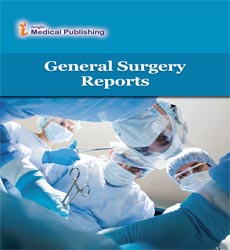Electrical Stimulation and Protein Supplementation into Early Post-Lung Transplant Rehabilitation
Vippual James*
Department of Pharmaceutical Sciences, University of Pittsburgh, Pittsburgh, USA
- *Corresponding Author:
- Adebayo Ade
Department of Pharmaceutical Sciences,
University of Pittsburgh, Pittsburgh,
USA,
E-mail: james@gmail.com
Received date: November 20, 2023, Manuscript No. IPGSR-23-18480; Editor assigned date: November 22, 2023, PreQC No. IPGSR-23-18480 (PQ); Reviewed date: December 07, 2023, QC No. IPGSR-23-18480; Revised date: December 14, 2023, Manuscript No. IPGSR-23-18480 (R); Published date: December 21, 2023, DOI: 10.36648/ipgsr.7.03.145
Citation: James V (2023) Electrical Stimulation and Protein Supplementation into Early Post-Lung Transplant Rehabilitation. Gen Surg Rep Vol.7 No.03:145.
Description
Unfortunate results in the early post-relocate period are believed to be brought about by actual disabilities related with appendage muscle brokenness and deconditioning. Neuromuscular electrical excitement has arisen as a harmless means to upgrade bulk and further develop recuperation in basically sick unfit to effectively take part in non-intrusive treatment yet was not concentrated on in the intense post-relocate setting. We fostered a recovery program that consolidates exercise based recuperation with NMES and protein supplementation to forestall muscle decay and work on utilitarian results after lung relocate a medical procedure. The patients were randomized to either the treatment arm (n=5) or regular consideration 72 hours after the transfer. The two gatherings of patients went through an underlying appraisal of muscle strength estimated by utilizing a handheld dynamometer and lower furthest point PC tomography assessment in something like 72 hours posttransplantation. Patients in the treatment arm got extra active recuperation in addition to NMES and sustenance supplementation during emergency clinic recuperation. Follow-up handheld dynamometer testing and lower limit CT was performed 14 days post-relocate. Contrasted with the norm of care bunch, the treatment bunch diminished normal ICU length of stay and diminished normal emergency clinic length of stay.
Muscle Strength
The change in handgrip measurement showed less of a decline in muscle strength in the treatment group. Also, there were diminished changes in thigh muscle region in the mediation bunch versus the benchmark group. The treatment bunch had less diminishing in the muscle strength surveyed by change in predominant hand handgrip estimation and thigh muscle region. Mean change among pattern and multi day follow up in handgrip estimation were 2.8 in the mediation bunch and - 0.8 in the benchmark group. Moreover, there were diminished changes in thigh muscle region in the mediation bunch versus control bunch. Joined non-intrusive treatment with neuromuscular electric excitement (NMES) seems, by all accounts, to be practical and protected during the intense postrelocate period and may decrease muscle squandering and worldwide muscle strength after the surgery. The outcomes can give the establishment to fostering a novel cardio thoracic recovery program with the possibility to further develop results of other cardiothoracic surgeries including heart transfers or CABG. A 52-year-elderly person gave vague stomach torment for 2 days. Actual assessment and figured tomography filter recommended stomach viscera hole and intense diffuse peritonitis. Segmental resections and sigmoidostomy were played out, the mid-region was briefly shut with a 3-liter mixture pack and kept up with for 72 hours.
Stomach Sepsis
Despite the fact that laparostomy is a helpful treatment of stomach sepsis, effective administration with free skin join transplantation after laparostomy has seldom been accounted for in stercoral hole. We report a patient with extreme stomach sepsis treated with harm control a medical procedure with free skin unite transplantation. The patient was released with great recuperation. Liver life systems have been broadly concentrated on all through the development of careful methods for the liver including transplantation. A more in-depth reevaluation of the anatomy of the liver has become necessary since the introduction of split and living donor transplants. However the life systems of individual curves of the liver have been portrayed carefully, the life systems of fragment 4 has never been made sense of already. We have meant to depict exhaustively, the life systems of portion 4 with its suggestions in hepatic-biliary medical procedure and liver transplantation with the thought that a sound comprehension of the life systems will lead to specialized developments during medical procedure and subsequently decline the bleakness and mortality related with these complex surgeries. Little digestive ischemic putrefaction was found, halfway resection of small digestive tract was performed later, and mid-region was as yet shut with the 3-liter imbuement sack and kept up with for 10 days. After one month, transitional split thickness without self-skin unite transplantation was performed. Midsection was shut a half year after the fact. In acute abdominal emergencies, damage control surgery has proven to be a more effective method for lowering the risk of death than definitive surgery.
Open Access Journals
- Aquaculture & Veterinary Science
- Chemistry & Chemical Sciences
- Clinical Sciences
- Engineering
- General Science
- Genetics & Molecular Biology
- Health Care & Nursing
- Immunology & Microbiology
- Materials Science
- Mathematics & Physics
- Medical Sciences
- Neurology & Psychiatry
- Oncology & Cancer Science
- Pharmaceutical Sciences
